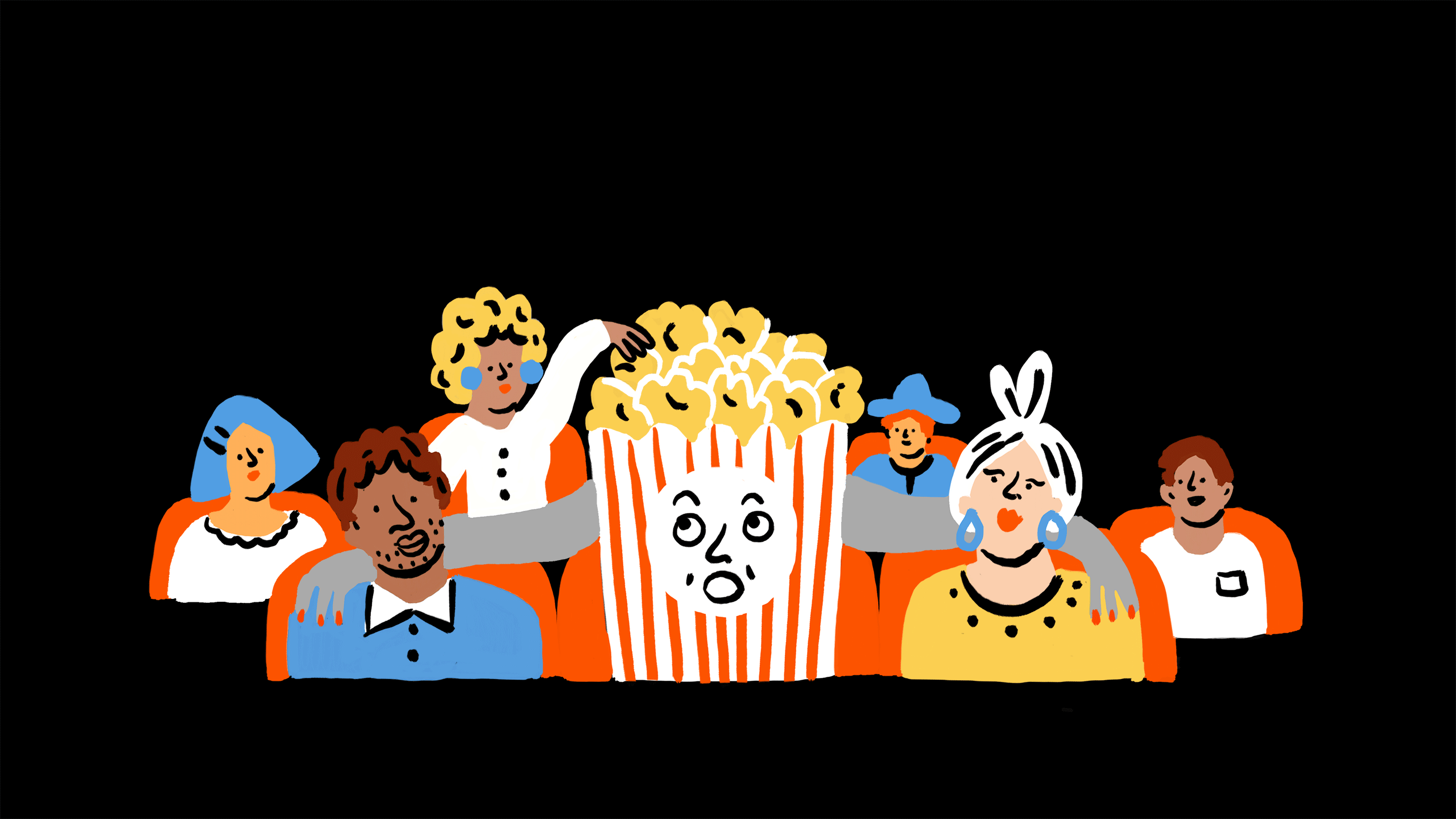It’s the year of apocalyptic cinema of the highest order, the year in which three of our best filmmakers have responded with vast ambition, invention, and inspiration to the crises at hand, including the threats to American democracy from a wannabe tyrant, the catastrophic menaces arising from global warming, the corrosive cruelty of ethnic hatreds and nationalist prejudices, and the poisonous overconcentration of money and power. The sheer enormity of the times has contributed to a sense of existential fury—of a challenge to modern life as a whole—in the year’s best movies.
At the same time, it’s a year of inside-movies practicalities, of special attention to the business at hand, because of the structural threats to the movie business from new and powerful players. The major crisis specific to cinema outleaps even the great merits of individual movies and invokes basic and comprehensive questions of which movies can be seen and how those movies are acknowledged.
New Yorker writers reflect
on the year’s best.

It’s been a terrific year for movies, but it would seem much less so if we only considered movies in wide release. Versions of that refrain come up every year, but what used to be merely a gap between the multiplexes and limited releases has now become an abyss. My list of the year’s best movies, below, is different this year, because this year in movies is different, in ways that are likely to become the new normal for movie viewing—and that are imposing new practices on critics who hope to keep up with what’s new in the art.
What’s different is that streaming is taking over, and, as a result, theatrical releases are declining—not numerically but qualitatively. We’re seeing a return to the bad old days of the nineteen-nineties, when many of the best international and independent films weren’t released at all. For most of the past decade, things were better, at least in New York: art houses programmed most of the best independent and international movies that had premièred at festivals, and some small theatres sprang up for the purpose of showing others. (Of course, even the sampling of movies that come to New York remains a mere sliver of what’s on offer in world cinema—a perennial problem.) Now few of the smaller venues have survived, and the better-established ones have, over all, turned less adventurous as they compete for an audience: the popularity of streaming movies and series at home has made it tougher for them to lure viewers to theatres.
Now that those better times have passed, the change for the worse raises a crucial underlying question: namely, what is the very definition of a release, who defines it to be so, and why—and why a release matters, or shouldn’t, to critics. Broadly speaking, a release is a consecutive seven-day run at a movie theatre. That definition is a distillation of the way that the term is defined by the Academy as a basis for Oscar eligibility—for the purpose of Oscars, the theatre must be in Los Angeles; for New York journals, in New York. Yet many extraordinary movies are getting shown in New York and do not receive seven-day runs: they only get shown once or twice, at festivals or special screenings, and therefore are not officially considered to have been released and are highly unlikely to be reviewed.
In lieu of a theatrical release, many worthwhile movies, after their festival and one-off showings, go straight to streaming services—where they’re instantly available to vastly more viewers than have access to a one-week New York run. Yet these streaming releases are caught in the same vicious circle: in the absence of a theatrical release, they’re unlikely to be reviewed. If a movie can be watched online but few viewers know about it, does it matter whether or not it’s there? The editorial policy that favors reviews of theatrical releases risks pushing already-overlooked films and filmmakers further into the margins, and even off the map.
There’s a bitter paradox in the reliance of Netflix and Amazon on theatrical releases of their best and most prominent productions and releases, such as “The Irishman” and “One Child Nation.” Of course, the streaming platforms are currying favor with filmmakers, who prioritize the theatrical experience; they’re positioning the movies for Oscars; and they’re positioning themselves as partners, not opponents, of the grand movie tradition. But, by putting their best movies in theatres and promoting the classical model of theatrical release as a marker of cinematic significance (Netflix has even reopened the Paris Theatre to do so), the services are also acknowledging the unlikelihood of such movies finding their streaming audiences in the absence of such theatrical releases.
On the other hand, such great and prestigious movies are only the cream of the cream of Netflix’s slate of movies and series. The rest of its flood of audiovisuals by the yard—like that of other services—has its own devastating way of drowning out independent and international films. With a price per viewing of zero, Netflix and Amazon Prime shows only have to be endurable. The situation brings to mind a word of wisdom from family lore: “For free, even vinegar tastes sweet.” Streaming is more than consumption; it’s compulsion. As the Netflix executive Reed Hastings said, in 2017, “We actually compete with sleep. And we’re winning.”
This flood of so-called content is a threat to something more than sleep—it’s a threat to the cinema. The danger is best understood in political terms, albeit ones that are ugly to cite. Last year, Steve Bannon told Michael Lewis, “The Democrats don’t matter. The real opposition is the media. And the way to deal with them is to flood the zone with shit.” Putting “independent filmmakers” in the place of “Democrats,” and “critics” in the place of “media,” clarifies the way that the current audiovisual content-sphere is approaching the cinemascape at large.
Despite the prominence of a few scattered prestigious titles, what dominates the streaming environment and overwhelms the popularity of any individual movie or show is the popularity of streaming itself—of a given service, whether it’s Netflix, Amazon Prime, Disney+, or another. What’s more, the popularity of streaming is similarly circular: the sheer quantity of what’s streaming also overwhelms the cinematic punditocracy with the sheer quantity of previewing, sifting, recapping, summarizing, comparing, and listing. The need to pay constant attention to the services rather than the works turns critics into connoisseurs of shit, comparing one mediocrity against another in order to be able to assemble a list of what’s barely recommendable with a straight face by contrast with what’s even worse. In the process, critical taste is inevitably shifted toward a new aesthetic (or anti-aesthetic) that leaves the best filmmakers of the time looking like backsliding conservatives clinging to ivory-tower traditions rather than what they are: audacious and forward-looking resisters to corporate production, not defenders but advancers of individual creation and conscience who overcome the redefinition of art as content—regardless of how their films may be marketed.
In this environment, when much of the best goes unreleased in theatres, the year’s list needs to be reconceived. Previously, I’ve mentioned noteworthy unreleased films as sidebars, or held them for later—because I had a reasonable expectation that they would in fact eventually be released. I’ve dismayingly been proved wrong too often. Many of the best movies I’ve seen recently haven’t yet had an official theatrical release. That’s why, this year, my list includes movies that haven’t been released—ones that I saw in festivals in 2018 and 2019 (though not including ones from the 2019 New York Film Festival, many of which are still snaking their way through the distribution pipeline). I’ve put these undistributed films on the list, in the place that they’d hold there if they were in fact considered official releases, and I’ve italicized them to emphasize both their difference and the cinematic ecosystem’s failure on behalf of some of its foremost works and artists.
The Best Movies of 2019: thirty-five released, eleven unreleased.
“The Irishman” (Martin Scorsese)
“The Dead Don’t Die” (Jim Jarmusch)
“An Elephant Sitting Still” (Hu Bo)
“Us” (Jordan Peele)
“Coincoin and the Extra-Humans” (Bruno Dumont)
“Uncut Gems” (Josh and Benny Safdie)
“My First Film” (Zia Anger)
“A Family Tour” (Ying Liang)
“One Child Nation” (Nanfu Wang and Jialing Zhang)
“Her Smell” (Alex Ross Perry)
“The Two Faces of a Bamiléké Woman” (Rosine Mbakam)
“A Beautiful Day in the Neighborhood” (Marielle Heller)
“Frankie” (Ira Sachs)
“Before Summer Ends” (Maryam Goormaghtigh)
“August at Akiko’s” (Christopher Makoto Yogi)
“Birds of Passage” (Cristina Gallego and Ciro Guerra)
“Atlantics” (Mati Diop)
“Richard Jewell” (Clint Eastwood)
“Hotel by the River” (Hong Sang-soo)
“Chaos” (Sara Fattahi)
“The Competition” (Claire Simon)
“Marriage Story” (Noah Baumbach)
“Pig” (Mani Haghighi)
“Burning Cane” (Phillip Youmans)
“Napalm” (Claude Lanzmann)
“Varda by Agnès” (Agnès Varda)
“Chez Jolie Coiffure” (Rosine Mbakam)
“Tux and Fanny” (Albert Birney)
“Harriet” (Kasi Lemmons)
“Little Women” (Greta Gerwig)
“Ad Astra” (James Gray)
“Sword of Trust” (Lynn Shelton)
“Return to Bollène” (Saïd Hamich)
“High Flying Bird” (Steven Soderbergh)
“Black Mother” (Khalik Allah)
“Cassandro, the Exotico!” (Marie Losier)
“Chained for Life” (Aaron Schimberg)
“The Laundromat” (Steven Soderbergh)
“American Factory” (Julia Reichert and Steven Bognar)
“Waiting for the Barbarians” (Eugène Green)
“The Image Book” (Jean-Luc Godard)
“Portrait of a Lady on Fire” (Céline Sciamma)
“The Burial of Kojo” (Blitz Bazawule)
“Two Plains & a Fancy” (Lev Kalman and Whitney Horn)
“Recorder: The Marion Stokes Project” (Matt Wolf)
“Ghosts of Sugar Land” (Bassam Tariq)

